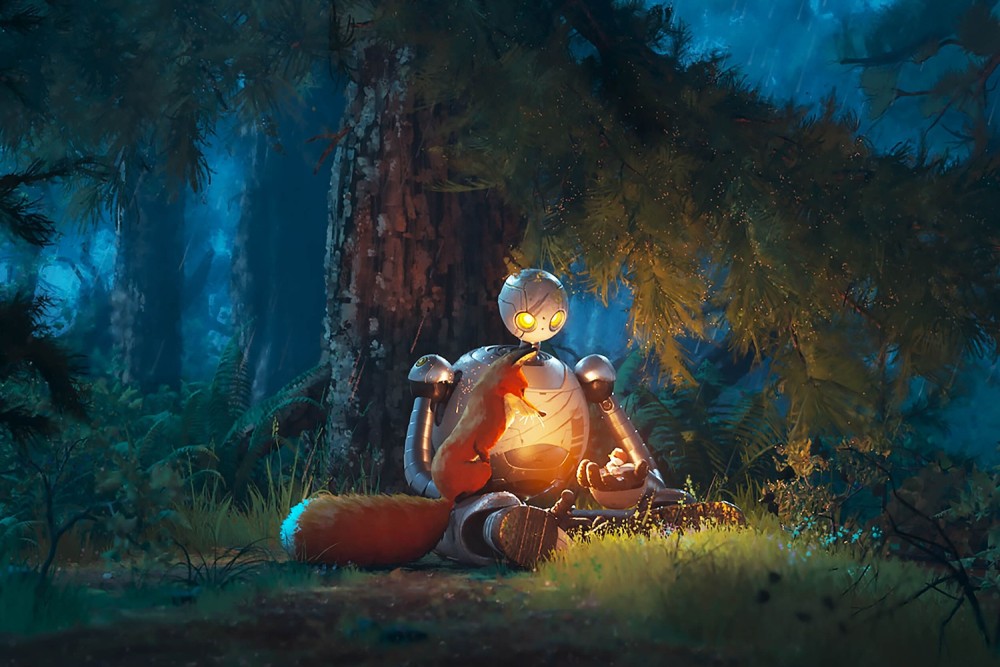The Wild Robot asks what makes us human
We are animals that need to overcome our instincts, robots that need to overcome our rationality.

Courtesy of DreamWorks
In the opening scene of the visually stunning animated movie The Wild Robot (directed by Chris Sanders based on the book by Peter Brown), a family of playful otters bob and dive in a small island inlet. Their curious faces and thrashing bodies are framed in the reflective surface of the eyes of a strange robotic figure, still half-encased in its smashed cargo case, battered by waves in the rough surf. As the otters climb all over the metal creature, sniffing and gnawing, one of them accidentally turns it on, and Rozzum 7134—Roz for short (voiced by Lupita Nyong’o)—springs to life. Roz knows that she is part of a new line of home helper robots developed by Universal Dynamics, a shadowy tech conglomerate, and she assumes that whoever turned her on is her new customer. Following her programming, she is eager to find her owner and complete her first task.
Roz speaks dozens of human languages, but she cannot understand any of the living creatures she encounters. She powers into “learning mode” and absorbs the chattering, squeaking, and growls of her new woodland companions until she can communicate with them. This doesn’t mean she understands them. As she crashes and bumbles through delicate ecosystems, she leaves a wake of destruction, including orphaning a runt gosling who is late to hatch from his nest. He imprints on her, as goslings do, and Roz acquires her first task—teach him to swim and fly and keep him alive until he can join the fall migration.
Read our latest issue or browse back issues.
Animated movies anthropomorphize all kinds of things—most often animals, but also ordinary objects like teapots and carpets—to stand in as proxies for humans or to act as their friends, guides, or foils in order to teach human viewers something about ourselves. Because there are no human characters in The Wild Robot, Roz occupies a strange in-between role in the allegory of the animated characters. She is partially a human proxy, the product of human intelligence and design, representing human imperatives that are out of place in a wild landscape. Reflecting the human ends for which she was built, she is obsessed with efficiency and calculation. “A Rozzum always completes its task,” she repeats with confident optimism as she stomps through the luscious natural landscape of the island. She is programmed to treat every biological creature she encounters as a potential customer, assessing its needs and calculating how she could maximize its life.
This doesn’t mesh very well in a landscape of predators and prey, where the food web requires that some lives prevail over others and where instincts for survival compete against a harsh landscape—weather, geology—that doesn’t adapt for the needs of biological life. Roz represents a certain vision of human intelligence, a modern view of ourselves as better, more rational, advanced beyond the imperatives of survival. Through our technology and tools, we can overcome the soft, vulnerable animality of our bodies.
There are hints throughout the film that what counts as technological advancement is really ecological destruction. Following a migration trail we see monuments of human achievement—the Golden Gate Bridge, most of Manhattan—now underwater, though we don’t know how or why this happened. The humans who invented Roz live in carefully managed, perfectly symmetrical cities encased in metal and glass domes, suggesting they can no longer survive in the environment they have permanently altered. The animated animals on the isolated island, in contrast, live in a truly wild place, one cut off from human advancement and human destruction.
Compared to these anthropomorphized animals, Roz appears like the robot she is. Her intelligence is too rational, her imperatives too unwavering. In this way, the anthropomorphized animals are our human proxies, teaching Roz the strange paradoxes of embodied, finite life. Many things that make life worth living, after all—like care and friendship and courage—are not efficient or task-oriented. As Roz learns to overcome her programming to follow the more powerful motivation of love, in turn she teaches the animals that they can, at least temporarily, override their instincts to work together to survive against harsh realities—extreme weather, direct assault—created by human agents.
This is a favorite theme of animated movies that involve anthropomorphized animals and machines. In movies like Madagascar 2, Zootopia, and even Beauty and the Beast, animal characters master their instincts to harm and eat each other. In movies like The Iron Giant and Big Hero 6, robot characters overcome their programming to develop more-than-rational attachments and love. These stories are not, of course, meant to teach us anything about a real lion’s ability to stop hunting zebra or our Roomba’s ability to love our baby; they are allegories about ourselves. We are the animals who need to overcome brute instincts. We are the robot-intelligence that needs to overcome our cold rationality. The Wild Robot’s addition to this long tradition of reflection is to help us see ourselves as always situated between our animal natures and our striving to overcome them, to help us take the measure of ourselves as the strange rational-irrational, finite-longing-for-infinity creatures we so often feel ourselves to be.
In the year since ChatGPT and other generative artificial intelligence systems have taken the world by storm, humanists of all stripes—and theologians and philosophers especially—have been newly energized by the question of what makes us human in distinction to these sudden displays of near-human or more-than-human intelligence. Old philosophies are dusted off and new ones are crafted to wrestle with this perennial question turned newly urgent. Animated kids’ movies are at least as good a place for this probing as any other. The Wild Robot is better than most—most other kids’ movies and maybe most other philosophies, too.







